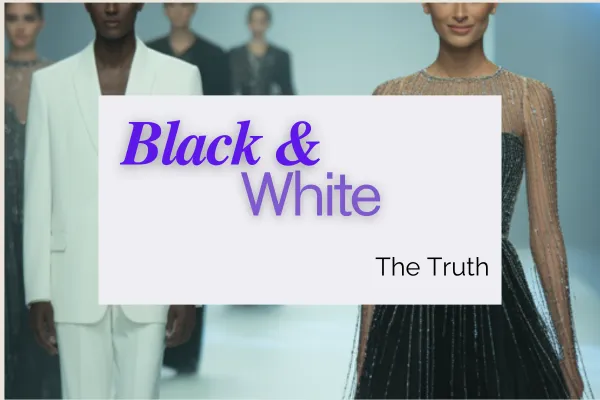
The Truth about wearing Black and White
The Truth About Wearing Black and White
Black and white are often considered the ultimate “safe” choices in fashion. They’re seen as timeless, classic, and versatile—yet the truth is, not everyone can wear them equally well. While these two colors may dominate wardrobes and fashion runways, how they look on you depends heavily on your personal coloring and style personality.
Why Black and White Aren’t Universal

Black and white create stark contrast. For some, that contrast highlights natural vibrancy and presence, while for others it can overwhelm, wash out, or even age their appearance. Every color group interacts differently with black and white, which means your best approach may not be the one-size-fits-all idea of “black goes with everything.”
How Different Color Groups Wear Black and White
Understanding your color group is the key to knowing how to approach these shades:
Cool Clears (Winters): Black and white are your power duo. You can wear them in sharp, bold contrast—think 70% black with 30% white for a crisp and polished look.
Cool Muted (Summers): Softer coloring benefits from a gentler balance. Aim for 70% white and just 30% black, keeping the overall effect light and refined.
Warm Tones (Springs & Autumns): Black and white are generally not your best allies. Instead, choose warm neutrals like camel, cream, chocolate, or olive, which harmonize beautifully with your natural warmth.
Bright Groups: Vibrant individuals can wear black and white with confidence, but the magic happens when you add bold color accents—a red lip, a turquoise scarf, or a statement accessory.
Dark Groups: You can rely on black as a strong foundation. Use white sparingly for balance, but don’t let it dominate.
Light Groups: Black can overwhelm, so keep it to less than 20% of your outfit. Softer, lighter tones will flatter more.
Soft Groups: Minimal black is best. When you do wear it, look for textured fabrics like tweed, lace, or knits that diffuse the harshness.

Not All Black and White Are Created Equal
Beyond the simple choice of wearing black or white lies the question of which black and white. The depth, shade, and texture make all the difference. A bright optical white may flatter Winters but appear harsh on Summers, who look better in softer off-whites. Similarly, a deep matte black differs dramatically from a glossy satin version.
Texture also plays a role. Crisp, sharp fabrics like cotton poplin or silk charmeuse intensify the impact of black and white, while textured fabrics—knits, lace, linen—can soften their severity and make them easier to wear.
One universal rule: almost everyone can wear black below the waist. Black trousers, skirts, or shoes provide a slimming, grounding effect, even for groups who avoid black near the face.
Practical Tips for Wearing Black and White
Consider your personal coloring before defaulting to black and white.
Use texture to soften harshness, especially if your coloring is light or soft.
Avoid extremely high-contrast combinations unless your natural coloring is also high contrast.
Choose accessories and shoes strategically to balance your look. A colorful necklace or scarf can make black and white more flattering.
The Final Word
Black and white are not fashion villains—but they’re not universally flattering either. By approaching them thoughtfully and tailoring your use to your color group, you can enjoy their elegance without compromising your natural radiance. The truth about black and white is simple: they should serve you, not the other way around.
Not sure if black and white truly work for you? Discover how to wear these classics in a way that flatters your unique coloring.
👉 Visit our Consultant Directory to connect with a professional image consultant near you and uncover your best black and white combinations.
